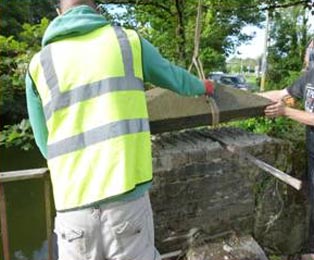Lee Moor Tramway Bridge ~ Plympton, Plymouth, Devon.
Client : Sustrans.

Sustrans is a charitable organisation who, amongst many things are responsible for creating and maintaining the 14,000 miles of walking and cycling routes throughout the U.K. On these routes over a million journeys take place on a daily basis. Many of these scenic routes make use of old canal networks and dis-used railway tracks.
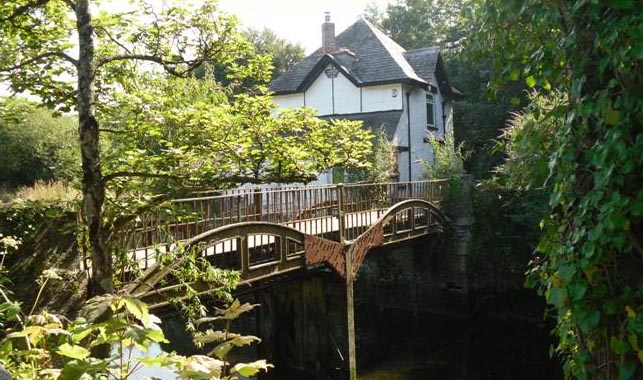
In Plymbridge Woods you will find the Cann Slate Quarry, where slate and elvan stone were extracted and its origins date back to at least 1671. By 1777 the quarry was owned by John Parker the Earl of Morley at Saltram Estate. To enable him to ship his slate out of the quarry he asked the engineer John Smeaton, who designed the famous lighthouse which we see on Plymouth Hoe today, to carry out a survey for a possible canal course from his slate quarry to Marsh Mills, Plympton. Smeaton suggested a twelve foot wide canal with locks but thought that slate production at the Earl’s quarry would not make the project cost effective so instead he suggested a tramway at half the cost. Both ideas came to nothing and the quarry carried on producing slate. However, by 1821 John Parker Junior the new Earl, decided to build a narrow navigable canal which was only six feet wide, this ran alongside the River Plym and was achieved by converting an existing 17th century mill leat.

This was eventually joined up with the wider estuary of the river Plym at Marsh Mills and the Plymouth and Dartmoor Railway Company constructed a junction to join his canal up with their railway line and the Lee Moor Tramway Bridge was put into place over the river Plym in 1823 to transport English China Clay to Plymouth from the quarries at Lee Moor. At this time the Earl of Morley was also extracting minerals on Lee Moor. The last horse drawn wagon crossed the bridge in 1961 to become a footbridge and today it’s part of the National Cycle Network. The canal officially opened up sometime between 1829 and 1830. It had no locks and was about two miles long, but in 1834 the railway company extended their track which followed the towpath of the canal all the way up to the quarry and the canal then reverted back to a leat purely to operate the Mills at Marsh Mills. The quarry today is owned and maintained by the National Trust and is a site of historical importance.
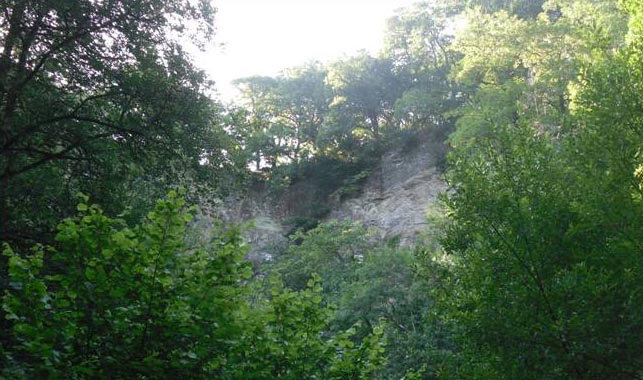
The old Cann Quarry, which is now home to Peregrine falcons.

The old cottages where workers at Cann Quarry once lived.

Above and below, the Cann Viaduct which spans the river Plym and cuts through Cann Quarry. Constructed from ‘Staffordshire Blue’ engineering brick, it was built between 1905 and 1907 and it replaced the previous viaduct which once stood here that was built from timber and stone. The original viaduct was designed by Isambard Kingdom Brunel.

We were approached by Sustrans and asked to take a look at the abutments of the old tramway bridge that spanned the River Plym at Plympton. A tree had fallen into the Plym during storms and after being washed downstream it hit the east abutment causing substantial damage to the stonework and placing the bridge at risk of collapse.

This cast iron bridge which is a heritage asset forms part of our environment that is valued because of its historical interest. Because of this the bridge is classified as a Scheduled Ancient Monument by English Heritage. This means it is an archaeological site, or sometimes it can be a historic building, of national importance and is, by law, given protection against unauthorized change. There is a legal requirement to maintain it under the ‘Ancient Monuments and Archaeological Areas Act 1979’ and is one of around 20,000 scheduled monuments around England. This act is a different law from that used for listed buildings because as a general rule a protected historic asset that is still occupied would be designated as a listed building.

The abutments are constructed from ‘dressed ashlar slate’, a Devonian slate which came from the original Cann Quarry and the ‘padstones’ which carry the weight of the actual cast iron bridge in the string courses within the abutments are made from Dartmoor granite. We were supplied with photographic records showing the stonework before any damage had occurred. All of the stones from the impact had fallen into the river and were retrievable. We had to, as far as the photographic records permitted us, try and identify what stone was what and where its original position was in the abutment and any stones that were missing or badly damaged had to be sourced, cut, dressed and matched in as close as we possibly could. The opposite abutment on the west side of the river did not sustain any damage at all from the fallen tree but still had to have substantial repairs done as a fair amount of stonework was missing from the abutment and this had probably happened over the course of many years.

Through Sustrans a meeting was arranged with the National Trust at Plymbridge to see if any stone was still lying around the old Cann Quarry which was suitable for us to use and re-dress for the replacement of stone within the abutments on the tramway bridge should we require it, and if so, could we have some. Early one morning we met up with the Head Ranger at Miner’s Cottage in Plymbridge and he took us up to Cann Quarry to take a look around. The first place we looked was a small overgrown corner opposite Cann Quarry called ‘Rumple Quarry’ which dates back to about 1761, and on further inspection it was found that there was an abundance of stone lying around in the undergrowth, it was going to be a bit of a jaunt to get it down to our 4×4 for transport, but nonetheless, after a bit of shaping and re-dressing it would be a perfect match as the stone for the bridge had originally come from here in the first place. Samples were taken away for the Inspector Of Scheduled Ancient Monuments to approve.
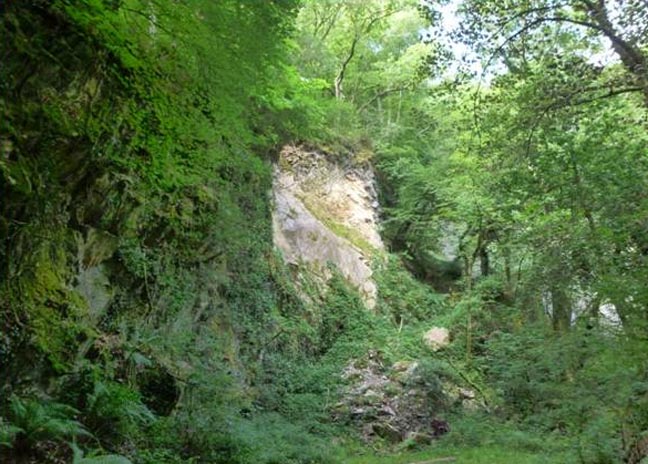



Working faces of the Rumple Quarry.

A pile of extracted stone lies abandoned on the quarry floor.

The remains of Rumple Quarry engine house.

An artist’s impression from one of the National Trust’s information boards depicting the Rumple Quarry engine house which was built in the late 1860’s. It housed a powerful steam engine which hauled the stone up from Rumple Quarry to the waiting trains on the Tavistock line. Rumple Quarry was considered a dangerous place to work due to overhanging rock formations and two men died at the quarry in 1861 after part of the working cliff face collapsed and slate production here ceased for two years.

Not too far away lies the remains of the Rumple Wheel Pit. Opened in 1865, it once supported a fifty foot diameter water wheel. It was constructed to replace a nearby steam powered winch but it was deemed a failure and only operated for a year, after which steam power was re-introduced. At the end of 1863, Rumple Quarry joined forces with Cann Quarry to become ‘The Plym River Slab & Slate Company Ltd’. By 1915 there was not much slate left to extract from these quarries but ‘Porphyritic Elvan’was still being exploited for use as window sills, paving stone and linings for furnaces, and shortly after this the quarries ceased to operate. Stone from these quarries had even been used to pave the streets of Piccadilly in London.

The first thing we had to do was to carry out a sample panel of repointing at high level to one of the pilasters on the tramway bridge using a mortar consisting of three parts of a course silver sand and one part of NHL5, a natural hydraulic lime, and this had to be passed for approval by the Inspector Of Scheduled Ancient Monuments. Both the repointing and the stone samples were approved and The National Trust granted us permission to retrieve stone from the old Rumple Quarry. Apart from getting a survey done to check for the presence of bats within the abutments of the bridge, we were now good to go ahead with the work. In the meantime we took a trip back up to Rumple Quarry to get the stone required for the repairs.

The track leading up through Plymbridge Woods to Rumple Quarry.


Plymbridge Woods itself has some stunning scenery and well worth a visit if you are in the area.


We got the 4×4 to within a hundred yards away from the quarry face itself and that was as close as we were going to get.


We then spent the morning searching around for stone suitable for use on the bridge and started filling up the back of the 4×4.

Once engineers from Sustrans had put a specification, risk assessments and method statements together, which had to be agreed by several bodies including English Heritage, The Marine Management Organisation and the Environment Agency to name a few, a site compound was set up and scaffolds were erected so that access could be gained to both abutments. Before any work could commence on the abutments an ecologist, Dr. Kate O’Neill, was appointed to check that bats were not present within the stonework underneath the bridge, another stipulation that had to be addressed for the organisation ‘Natural England’. No evidence of bats were found, which meant we could now start the repairs.
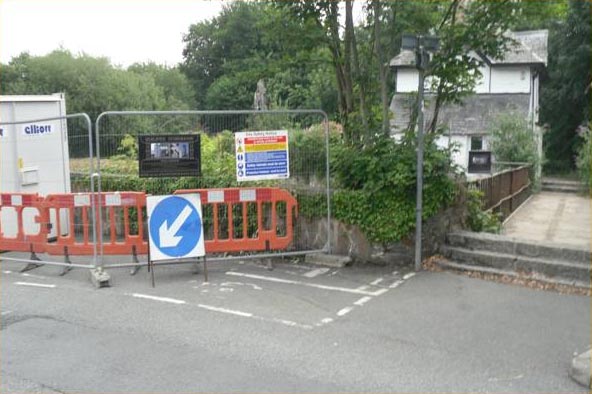
The specification outlined that a couple areas of stonework within the abutments had to be rebuilt, using as much of the salvaged stone from the river as possible, vegetation growth affecting the stonework treated, several individual stones also needed to be pieced in where required and repointing to the stonework in general, all using NHL5 Hydraulic lime mortar and causing minimal amounts of disruption to the stonework as possible during the course of the works. Our first task was to find the stone in river, clean it up, determine its original position, record it and set it aside for re-building.



Once all the stone had been identified we started to rebuild the abutments to match existing photographic records we had.




We then had to address all the root infestation. Most of it was at the higher levels within the abutments. Small vegetation growth that was attached to the surface of the stonework was gently pulled away. Deep root infestation which is firmly rooted within the stonework was cut back close to the face of the stonework. This was then drilled and injected with a strong herbicide. This method is favoured because to get the roots out completely it would mean disturbing much of the surrounding masonry, it is better to treat the roots in this way and let them die off so as not to displace any of the existing stonework.
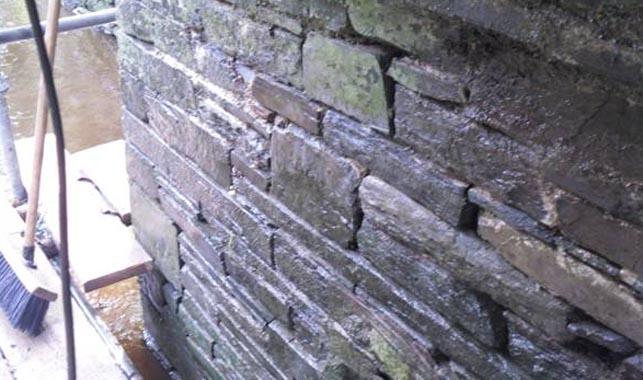
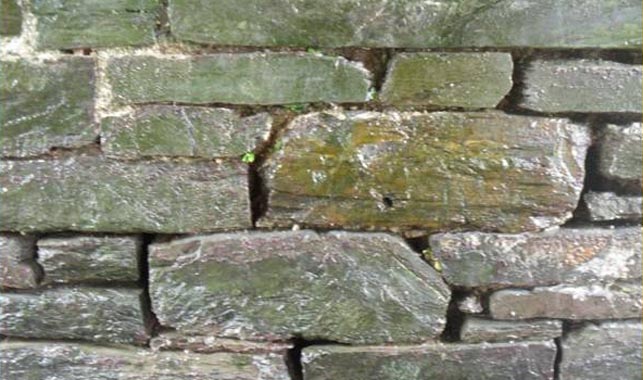

Once the vegetation problems were sorted out, the joints to the stonework on both abutments were cleaned, prepared and re-pointed with the specified mortar and individual stones were pieced back in as required. The building and re-pointing work had to fit in with the tide times and everyday all the work we had carried out would get completely covered by the rising tides. The two pockets in the stonework you see in the picture above once had timber supports built into them, probably to support sections of the bridge at one time or another, and these had to remain as they were.

The bridge has four pilasters, two of these are each capped off with a granite capping stone, the other two were missing. Luckily one of them which originally sat on one of the pilasters on the west side of the bridge was lying on the river bed below, still intact with no damage at all. This had to be retrieved and set back in its original place. Unfortunately, after a fruitless search in nearby undergrowth and the immediate area within the river channel, the fourth capping stone was nowhere to be seen and is now lost for all time.

An area was cordoned off and a J.C.B put in place to lift the granite capping stone out of the river.


Once out of the river the capping stone was set back into its rightful place.
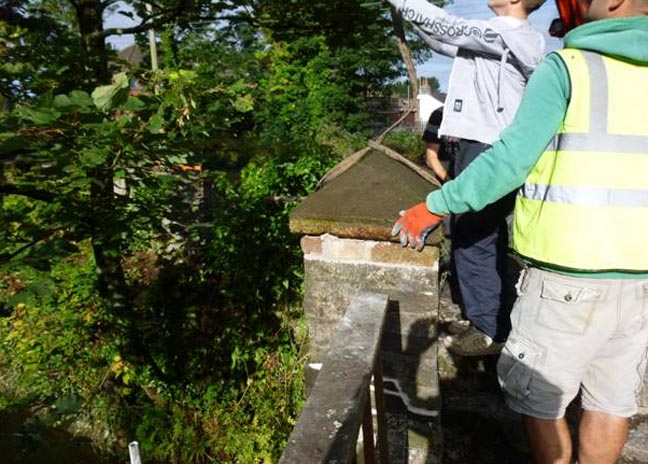
It’s interesting to note that one day an elderly chap turned up on site and produced a photograph that he took in 1968 of the bridge and this photograph showed that the granite capping stone was not in place back then, which meant that it had been sitting on the river bed for at least forty-five years.



Once all the work was completed, the site compound was taken away, the scaffolds dismantled and we were heading off to the next job!





